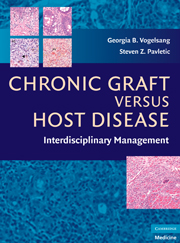Book contents
- Frontmatter
- Contents
- List of Contributors
- Preface
- PART I GENERAL PRINCIPLES
- PART II CLINICAL MANAGEMENT
- PART III ORGAN SITE OR SYSTEM-SPECIFIC MANIFESTATIONS
- 16 Cutaneous Manifestations of Chronic Graft versus Host Disease
- 17 Oral Chronic Graft versus Host Disease
- 18 Chronic Ocular Graft versus Host Disease
- 19 Gynecological Manifestations of Chronic Graft versus Host Disease
- 20 Gastrointestinal and Hepatic Manifestations of Chronic Graft versus Host Disease
- 21 Chronic Graft versus Host Disease and the Lung
- 22 Hematologic Complications of Chronic Graft versus Host Disease
- 23 Neurological Manifestations of Chronic Graft versus Host Disease
- 24 Rehabilitation Evaluation and Treatment of Patients with Chronic Graft versus Host Disease
- 25 Infections
- 26 Endocrine and Metabolic Effects of Chronic Graft versus Host Disease
- 27 Other Manifestations of Chronic Graft versus Host Disease
- 28 Psychosocial Issues in Chronic Graft versus Host Disease
- 29 Secondary Malignancies and Other Late Effects
- 30 Health-Related Quality of Life (HRQOL) in Chronic Graft versus Host Disease
- PART IV SPECIAL CONSIDERATIONS IN CHRONIC GVHD
- Index
- Plate section
27 - Other Manifestations of Chronic Graft versus Host Disease
from PART III - ORGAN SITE OR SYSTEM-SPECIFIC MANIFESTATIONS
Published online by Cambridge University Press: 26 August 2009
- Frontmatter
- Contents
- List of Contributors
- Preface
- PART I GENERAL PRINCIPLES
- PART II CLINICAL MANAGEMENT
- PART III ORGAN SITE OR SYSTEM-SPECIFIC MANIFESTATIONS
- 16 Cutaneous Manifestations of Chronic Graft versus Host Disease
- 17 Oral Chronic Graft versus Host Disease
- 18 Chronic Ocular Graft versus Host Disease
- 19 Gynecological Manifestations of Chronic Graft versus Host Disease
- 20 Gastrointestinal and Hepatic Manifestations of Chronic Graft versus Host Disease
- 21 Chronic Graft versus Host Disease and the Lung
- 22 Hematologic Complications of Chronic Graft versus Host Disease
- 23 Neurological Manifestations of Chronic Graft versus Host Disease
- 24 Rehabilitation Evaluation and Treatment of Patients with Chronic Graft versus Host Disease
- 25 Infections
- 26 Endocrine and Metabolic Effects of Chronic Graft versus Host Disease
- 27 Other Manifestations of Chronic Graft versus Host Disease
- 28 Psychosocial Issues in Chronic Graft versus Host Disease
- 29 Secondary Malignancies and Other Late Effects
- 30 Health-Related Quality of Life (HRQOL) in Chronic Graft versus Host Disease
- PART IV SPECIAL CONSIDERATIONS IN CHRONIC GVHD
- Index
- Plate section
Summary
INTRODUCTION
Chronic graft versus host disease (cGVHD) is a multisystem alloimmune and autoimmune disorder characterized by immune dysregulation, immunodeficiency, impaired organ function, and decreased survival. cGVHD is characterized by the development of features reminiscent of various autoimmune or immunologic disorders, such as scleroderma, Sjogren's syndrome, chronic immunodeficiency, and bronchiolitis obliterans. cGVHD typically involves the skin and dermal appendages, mouth, eyes, genitalia, gastrointestinal tract, liver, lungs, musculoskeletal system, and hematopoietic system. More rarely, cGVHD can involve the heart or kidneys, or manifest as vasculitis, serositis, or myasthenia gravis (MG). These unusual manifestations are rare and other causes such as drug toxicity and postirradiation effects should be considered.
MYASTHENIA GRAVIS
Incidence
Myasthenia gravis is an autoimmune disease resulting from the production of autoantibodies that bind to the acetylcholine receptor (anti-AchR Ab) of the neuromuscular endplate. This binding causes impaired transmission at the neuromuscular junction, leading to skeletal muscle weakness and fatigue. Despite the fact that approximately 20% of patients with cGVHD show anti-AchR Ab, the frequency of clinically apparent MG after hematopoietic stem cell transplantation (HSCT) is relatively low. There are only a few case reports describing MG following HSCT in the literature. MG has been reported as far out as 9 years following HSCT and only one patient has developed MG without evidence of cGVHD. MG has been reported in children as well as adults and there appears to be no gender predilection.
- Type
- Chapter
- Information
- Chronic Graft Versus Host DiseaseInterdisciplinary Management, pp. 302 - 313Publisher: Cambridge University PressPrint publication year: 2009

